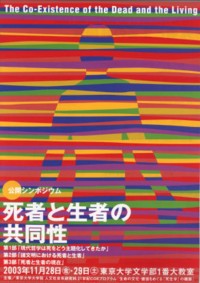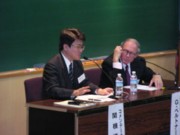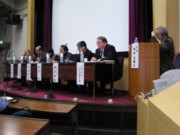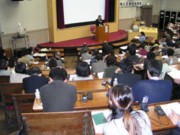
 |
|
Symposium :
|
|
November 28-29, 2003 at Lecture Hall 1, Faculty of Law & Letters Bldg.2, The University of Tokyo
|
 |
Section 1 : Lecture
How has contemporary philosophy conceptualized death?
November 28 15:30-17:15
On November 28th, the symposium started with an opening address by Prof. Takeshi Inagami (the chair of Graduate School of Humanities and Sociology) which included a memorable recounting of his experience of his mother's recent death. Following this, Prof. Seizo Sekine (the general moderator) explained the intention of this symposium explaining that the aim was to make a comparative study of the differing positions to understand death and life among people in modern Japan and in other various civilizations. There were three sections in the symposium.
The topic of the first section was "How has contemporary philosophy conceptuarised death?" (the moderator of this section was Prof. Jyun Matsuura .) Prof. Günther Pöltner (Universität Wien) gave a keynote speech titled "Aspekte gegenwaertigen philosophischen Todesverstaendnisses." He pointed out the resent trend to consider death as "nothing" without relying on metaphysical understandings of death seen in the ideas of "the world beyond," "reincarnation'' and so on. Prof. Sekine, as a commentator, responded to this speech with some questions as to what differences and relations are among the concept of "nothing" by Heideggar, that of "nothing" having cultivated in Western tradition and that of "absolute nothing" maintained in the system of Asian philosophy was, how the co-existence of the dead, who lives in our memories, and the living would be by restoring the view of "others" that ego-centric philosophy illuminated.
Section 2 : Symposium
The dead and the living in various civilizations
November 29 10:00-12:30
The second section was held in the morning on November 29th. Its topic was "The dead and the living in various civilizations" (the moderator of this section was Prof. Masaru Ikezawa). Although it was a rainy day, so many people as the previous day came to the symposium.
Panelists of this section was Prof. Stephen F. Teiser (Princeton University) and Prof. Hisao Miyamoto (the University of Tokyo). Prof. Teiser made a presentation on the geometry of death in Buddhism, using slides. Prof. Miyamoto formulated the scheme to demonstrate the ways in which festival space created in the community, characterized by its member's life and the member's symbolical/social death (eg.. refugees who have no civil rights) and the living (community of refugees). Prof. Gaynor Sekimori (the University of Tokyo) and Assistant Prof. Kazuko Shiojiri (University of Tsukuba), as commentators, responded to them by taking up some topics of Shugen-do in Japan and Islam.
Section 3 : Symposium
The present context for the dead and the living
November 29 14:00-18:00
After the lunch break, the third section "The present context for the dead and the living" began. (The moderator of this section was Prof. Fumihiko Sueki .) Its panelists were Prof. Hiroshi Watanabe (the University of Tokyo), Prof. Tetsuo Watanabe (Tokyo Medical and Dental University) and Prof. James H. Foard (Arizona State University). Commentators were Assistant Prof. Kakumyo Kanno (University of Tokyo), Prof. Fabio Rambelli (University of Sapporo) and Prof. Kunimitsu Kawamura (University of Osaka).
Prof. Watanabe Hiroshi discussed the death and life in "modernity" as expressed in Western music, using a CD of funeral marches and requiems. The commentator, Assistant Prof. Kanno, responded to this presentation by questioning how the relationship between modernity in Western music and Western politics. Prof. Watanabe Tetsuo gave a warning to us contemporary people from the viewpoint of psychopathology, arguing about one case of schizophrenia brought about by ignorance of the co-existence of the dead and the living lying in one's mental depth. The last panelist, Prof. J. Foard, suggested that for us who experienced the Holocaust in Hiroshima, the only purpose of understanding the meaning of nonsense mass murders is to apply our knowledge, memories and experiences of these historical mass murders in preventing mass murder which may happen in the future.
Midst much applause by the audience, the symposium was broken up with a closing address and an address of thanks to the audience, guests and staffs by the leader of COE program, Prof. Susumu Shimazono .
 |
 |
 |